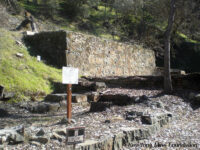Discover the magic of California’s smallest city.
If you like Gold Country towns with history, charm and a sense of being buffered from the noisy outside world, Amador City is as good as it gets.” — Peter Fish, San Francisco Chronicle
Welcome to Amador City! Located along California’s historic Highway 49, Amador City is the ultimate destination for a unique day trip or weekend getaway. Boasting rolling valleys, rich history, and a myriad of small-batch wineries, breweries, and artisanal eats, there is always something to new to discover in AC.
As one of California’s smallest incorporated cities, Amador City is a small town with a big heart. With a total area of 0.3 square miles and a population of just over 200, we invite you to stroll through our town and experience what makes our little town so special.
Step back into the Gold Rush and see Amador City through the eyes of its women. Walk up Main Street to discover the local flavors of California wine country. Find new and old treasures at one of our many purveyors and antique shops. When you get away to Amador City, you’ll uncover the magic of California off the beaten path.
A City Built on Gold

Amador City is named after José María Amador, a wealthy California rancher who who mined in the area with the Sunol group from 1848-1849. Although José María Amador left the group after six months to return to his family and rancheria, he made a significant impact in the area that now carries his namesake. Meaning “lover” in Spanish, Amador’s name is honored throughout the city, county, and creek.
It was along the creek that gold outcroppings were discovered and mining camps started springing up in the area in 1848. The Original (or Little Amador) Mine and the Spring Hill Mine were likely the country’s first gold mines. As gold was mined out on the upper part of the creek, mining and encampments gradually moved to “South Amador” where French Gulch is abundant.
The Keystone Mine, established in 1853, was the city’s most famous gold mine and a major contribution to the growth of the town. In those days, there were an estimated four to six thousand residents in Amador City. Before closing in 1942, an estimated $24,000,000 in gold had been extracted from the Keystone Mine. Amador City was officially incorporated as a city on June 2, 1915.
Amador City’s oldest structure, built around 1855, is now home to the elegant Imperial Hotel and restaurant. Up Main Street, you will find the stone Fleehart Building, now the Whitney Museum), which dates from the 1860s.
Historic Sites

Consolidated Keystone Mine
The Keystone Mine was founded in 1853 from a consolidation of 2+ small claims. It was 2,680 feet deep and produced about $24 million in gold in its lifetime. While its early years were plagued with problems, a rich new vein was discovered in 1866, making Keystone one of the most lucrative California mines. The Keystone Mine was closed in 1942 when the government closed all operations that did not pertain to the war effort.

Fleehart Building
The Fleehart Building is most likely Amador City’s oldest building, dating from the 1860s or earlier. William Fleehart was an early day mine owner, merchant and Wells Fargo agent. It may also have been an early Keystone company store. The Fleehart was the only store building to survive the big fire of 1878. The building has since been donated to the city and houses the Amador Whitney Museum.

Kling Building
Kling’s Saloon burned down in the June 1878 fire. The present brick building, completed in January 1878, housed George Kling’s saloon on the south side and Hewitt and Hammack’s dry goods and grocery on the north side. The north side later housed a justice of the peace, a cobbler’s shop and an assay office. In July 1879, Kling graded the lot between his new brick saloon and Kirkland’s stone store (the Fleehart building) and built a frame store, which was evidently torn down.

Imperial Hotel
Before the June 1878 fire, a wooden hotel stood in the heart of Amador City. After the fire, owner B. Sanguinetti erected a two-story frame addition behind the hotel to house the overflow, which was later removed. It remained a hotel until 1927. After careful restoration, the building has returned to its original use. The site is now home to the Imperial Hotel which features beautifully decorated rooms, the Oasis Bar, elegant dining, and more.

Amador Hotel
The main entrance of the Amador Hotel was built around 1855 which escaped the fire of 1878. In 1872, owner Harrington completed a new and commodious hall which was used as a town hall. In 1876, he nearly doubled the square footage, adding a drug store, doctor’s office and more apartments. It was used as a hotel until the 1940s, and reportedly housed ladies of the evening during some periods. It is believed to be Amador City’s oldest structure.

Culbert House
The Culbert House was built circa 1870. Originally designed as two houses, it was inhabited by John Culbert’s grandmother and her sister. The Culberts were a pioneer family in Amador City prominent in ranching, logging, and mining. John Culbert and his wife later combined the two houses into one and filled it with an extensive antiques collection. Until recently, the home was a Bed and Breakfast Inn but is now a private residence.

